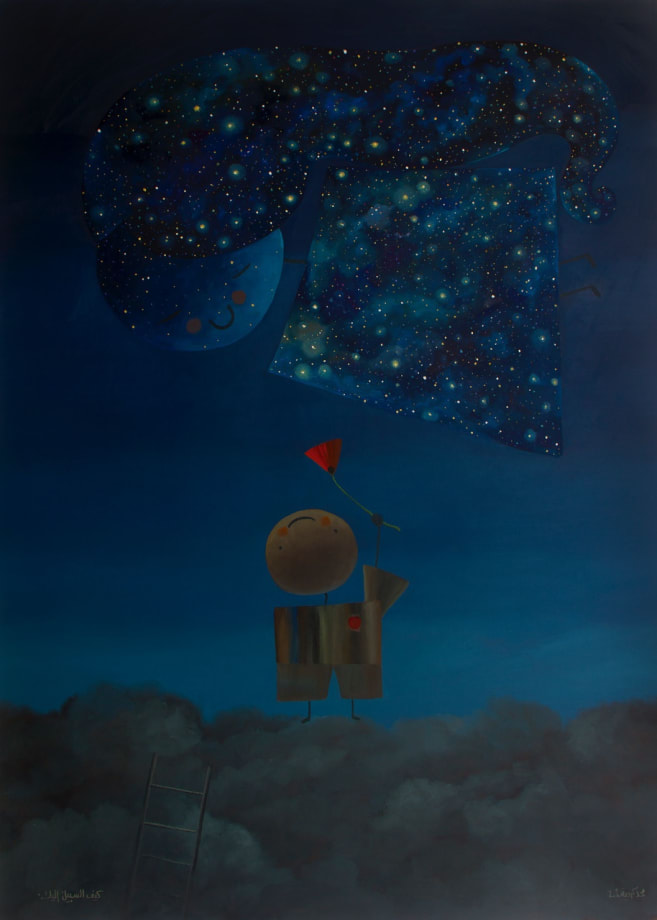Fann A Porter is pleased to present a group booth of emerging and established artists, whose works reach the viewers effortlessly.
Majd Kurdieh’s Very Scary Butterfly Gang and The Fasaeen continue their mission to steal the sorrows and sadness of the neighbors paint a smile on all faces. Majd Kurdieh is a painter whose childlike drawings speak to the soul. His work is a combination of art and literature. The painter lives on the edge of a forest in Lebanon away from civilisation and closer to nature where he dreams up his paintings like an alternative world. He uses cartoon-like characters to talk about the current state of the world.
Most of Kurdieh’s works are accompanied by his quotes in Arabic that translate to positive or powerful messages. His works revolve around two characters, Fasaeen, one boy (Fasoon) and one girl (Fasooneh), who are always smiling despite the fact that their world is filled with hardships. Fasoon and Fasooneh are joined by a ‘gang’ made of other animal characters called the ‘Very Scary Butterfly Gang’. Together, their main mission is to steal sadness looming over the world with their sole weapon, the flower
Figurative painter Houssam Ballan’s canvases are informed by his accomplished technical abilities and through his extensive academic and research endeavour. As an artist, Ballan’s frequent experimentation informs the growth in his work as he works intuitively. In his earlier paintings, Ballan’s young protagonists are executed with close attention to detail, a form of realism that relies on painterly effects and meticulous line work to create a sculptural sense of figuration. As the bodies of his subjects are given dimensionality, the artist renders their clothes as lines, patterns, and evident brushstrokes with a stylisation that alludes to the passage of time and the presence of an ongoing narrative.
At the centre of his work is the idea that representation cannot solely be based on what one sees, but the understanding of what one is seeing and the feelings it invokes in a person - be it through looking at it from different angles, touching it, allowing it to move you subconsciously, as well as other experiential interactions. Drawing upon the idea that when one tries to remember a person or a specific incident, that person or incident is not remembered in concrete shapes and lines and colours, but blurred into an overall multi-dimensional feeling, the artist minimalises the detail in his work.
Omar Najjar’s brush strokes bring in life and movement to the abstract, dragging the viewer voluntarily into that captured slot in time, to live and experience it again and again. Known for his innovative style that he describes as “structured chaos,” Najjar's paintings come across as a modern take on impressionism; their quotidian subject matter is elevated to the sublime, providing a profound, if understated, view of the human experience. Through manipulating oil, pastels, and charcoal, Najjar's work is characterized by broad brushstrokes that give a suggestion to the story without giving the details fully.
Othman Moussa’s early paintings capture the often-overlooked poetics of the mundane in realist still lifes that feature humble offerings, for example, a battered but polished cooking pot alongside a lone pomegranate or a rusted teapot that glimmers as its exterior catches light. Recalling the naturalism of Spanish still lifes, his initial series emphasises that which provides sustenance with reflective detail and a spiritual sense of monumentality. As the artist’s aesthetic progressed, his arrangements of inanimate objects began to take on allegorical traits, evincing subjective themes such as love and desire.
Recently, the impact of the Syrian conflict has entered his compositions, turning everyday objects into subjects of war. Although these works are accomplished with greater realism, Moussa has simplified his compositions by not including the embellishments of classical examples, such as the silken white cloth in Dutch still lifes that guides the eye across elaborate table settings. Isolating his objects, he focuses on jarring pairings. In these latest works, something as simple as food is now transformed into a weapon, reflecting the presence of violence in the most minor details of life. Other paintings of the series utilise satire as a biting form of social commentary as the thrones of absent monarchs are portrayed in an absurd manner and symbols of power are stripped of their aura.

